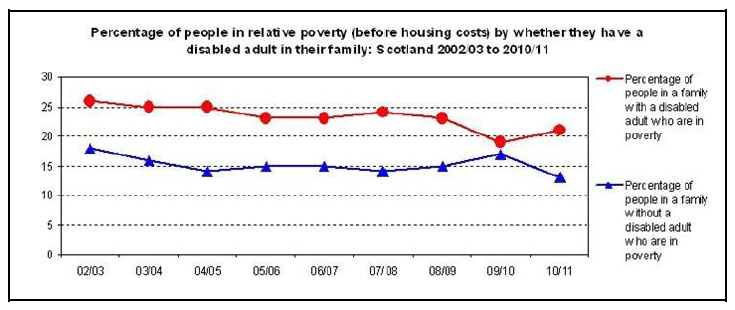Scottish Government Equality Outcomes: Disability Evidence Review
This evidence review was prepared to support the production of the Scottish Government's Equality Outcomes, with regard to disability.
6 Poverty
6.1 This section looks first at the incidence of poverty, and then at the anticipated impacts of welfare reform.
Incidence of poverty
6.2 The Scottish Government's Disability and Poverty analysis (2011)[36] shows that people who live with a disabled adult in their family are more likely to be in relative poverty (before housing costs) than those who do not - see Figure 6 below. Throughout the period 2002/03 to 2008/09, the proportion of individuals in relative poverty (before housing costs) was approximately 8 percentage points higher in families containing a disabled adult than in families with no disabled adults. In 2010/11 this was again the case, after a brief narrowing to 3 percentage points in 2009/10: as some of the sample sizes underlying these estimates are small, caution should be exercised in the interpretation of year-on-year fluctuations, and identification of trends should be based on data for several years. The reader should note that these poverty figures are based on income and do not take into account any perceived higher cost of living of many disabled people; for more detail on the possible over-estimation of living standards, see pages 7-9 of the Equivalence Scales[37].

Figure 6: Disability and relative poverty, 2002/03 to 2010/11. (Source: Scottish Government Disability and Poverty analysis, 2011)
6.3 The Scottish Government's research report, The position of Scotland's equality groups: revisiting resilience in 2011[38], reports that:
- Households with one or more disabled people are much more likely to have no working members compared to households without disabled people (64% and 25% respectively).
- More positively, in-work poverty is lower for households with one or more disabled people than for households without disabled people (3% and 7% respectively).
6.4 The Scottish Household Survey (2009/10) found that disabled people were less likely to be coping financially[39]. Households that contain at least one person with a long-term illness or a disability are more likely to be 'not coping' (15%) than those that do not (10%). The corresponding 'coping' figures are 41% and 53% respectively.
6.5 The Wealth and Assets Survey (2006/08)[40] reported that households across Great Britain with a member with a long-standing illness or disability do not appear to be particularly disadvantaged in wealth distribution compared to households where there is no disability. However, there is wide inequality in wealth levels between disabled households, although it is not possible to establish the extent to which wealth is affected by different impairments.
6.6 The Family Resources Survey (2007/08)[41] found that disabled people across Great Britain in all age categories are more likely than non-disabled people to have no bank account and no home contents insurance. This appears to be particularly true for people with a learning disability.
Welfare reform
6.7 The Department for Work and Pensions has published an Equalities Impact Assessment for the Universal Credit[42]. It models the expected positive impact of Universal Credit for people moving into ten hours of work per week at the minimum wage. It does this by calculating the participation tax rate, which is the proportion of earnings which are lost in tax, national insurance or reduced benefit payments, when a person moves into work. The improvement in participation tax rates is seen for disabled as well as non-disabled people:
- It is expected that far more people will have a relatively low participation tax rate (of below 60%) when Universal Credit comes in. The proportion of disabled people who have this low participation tax rate increases from 20% under the current system to 90% under Universal Credit. For people without a disability, the proportion with low participation tax rate increases from 46% to 98%.
- It is also expected that fewer people will have relatively high participation tax rate (of above 70%) when Universal Credit starts. Just 4% of disabled people will face a high participation tax rate under Universal Credit, compared to 33% under the current system. Only 1% of people without a disability would face a high participation tax rate under Universal Credit.
6.8 The Department for Work and Pensions explains that, under Universal Credit, disabled people see slightly higher participation tax rates than non-disabled people because disabled people are more likely to be claiming benefits outside of Universal Credit (such as Carer's Allowance or Contributory Employment and Support Allowance) which increases their participation tax rates. The interaction with contributory benefits and carers' allowance also accounts for the small proportion of disabled households with participation tax rates in excess of 90% under Universal Credit. The higher earnings disregards for disabled people should mean that their work incentives are significantly improved from the current system.
6.9 The Department for Work and Pensions equality impact assessment of the new Benefits Cap[43] explains that the cap will not apply to households where someone is in receipt of Disability Living Allowance (or its replacement, the Personal Independence Payment, from April 2013), Attendance Allowance, Industrial Injuries Benefit or the support component of Employment and Support Allowance. However, it observes that disability can be defined in a number of ways, and receipt of these benefits is just one potential way. Of the households who lose from this policy, based on internal modelling, the Department for Work and Pensions expects that roughly half will contain somebody who is classed as disabled under the Equality Act.
6.10 The Department for Work and Pensions' equality impact assessment of the abolition of the 'youth' provision for Employment and Support Allowance (ESA)[44] touches on the intersection between disability and age, in the context of welfare reform.
Contact
Email: Social Research
There is a problem
Thanks for your feedback